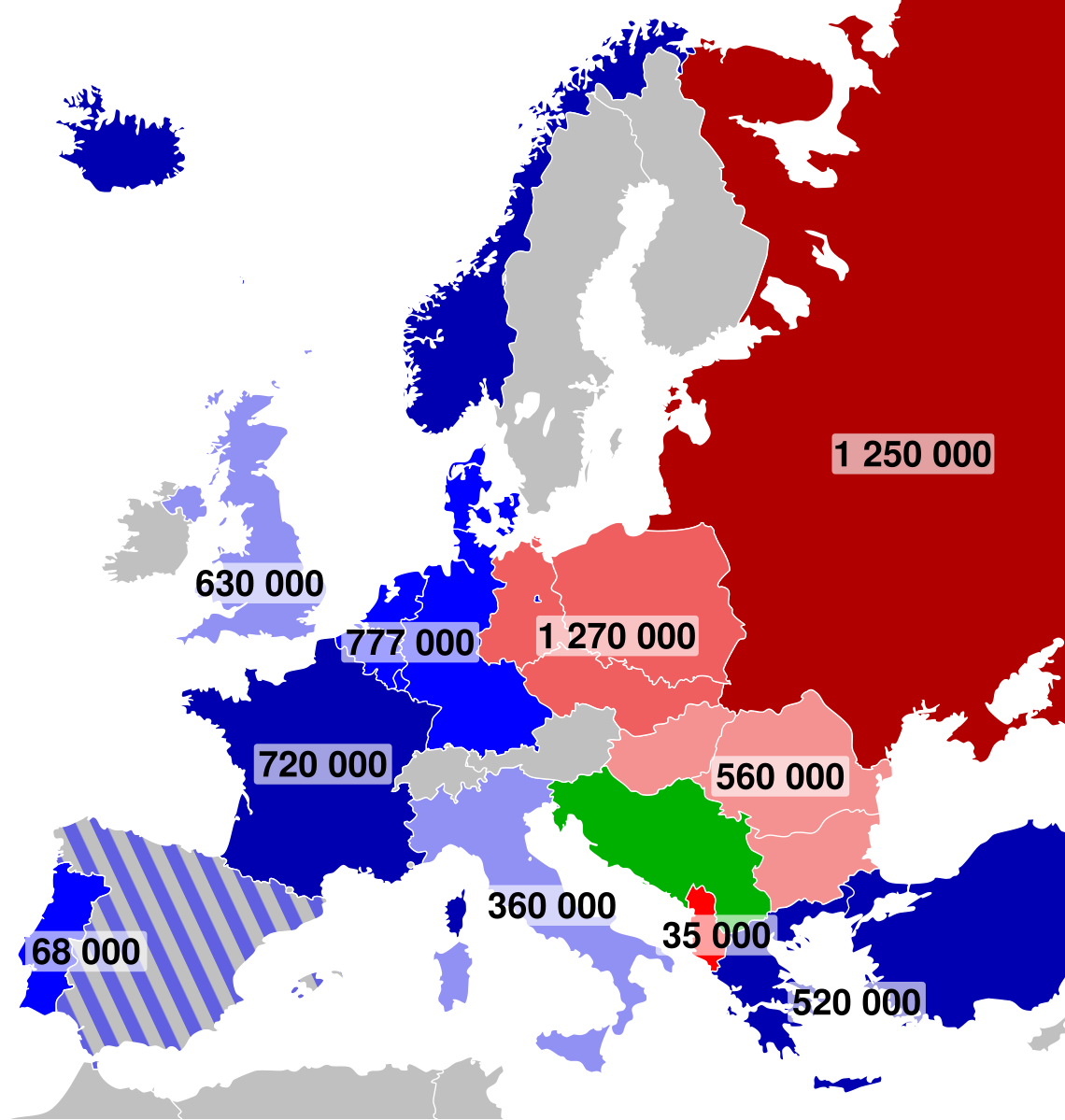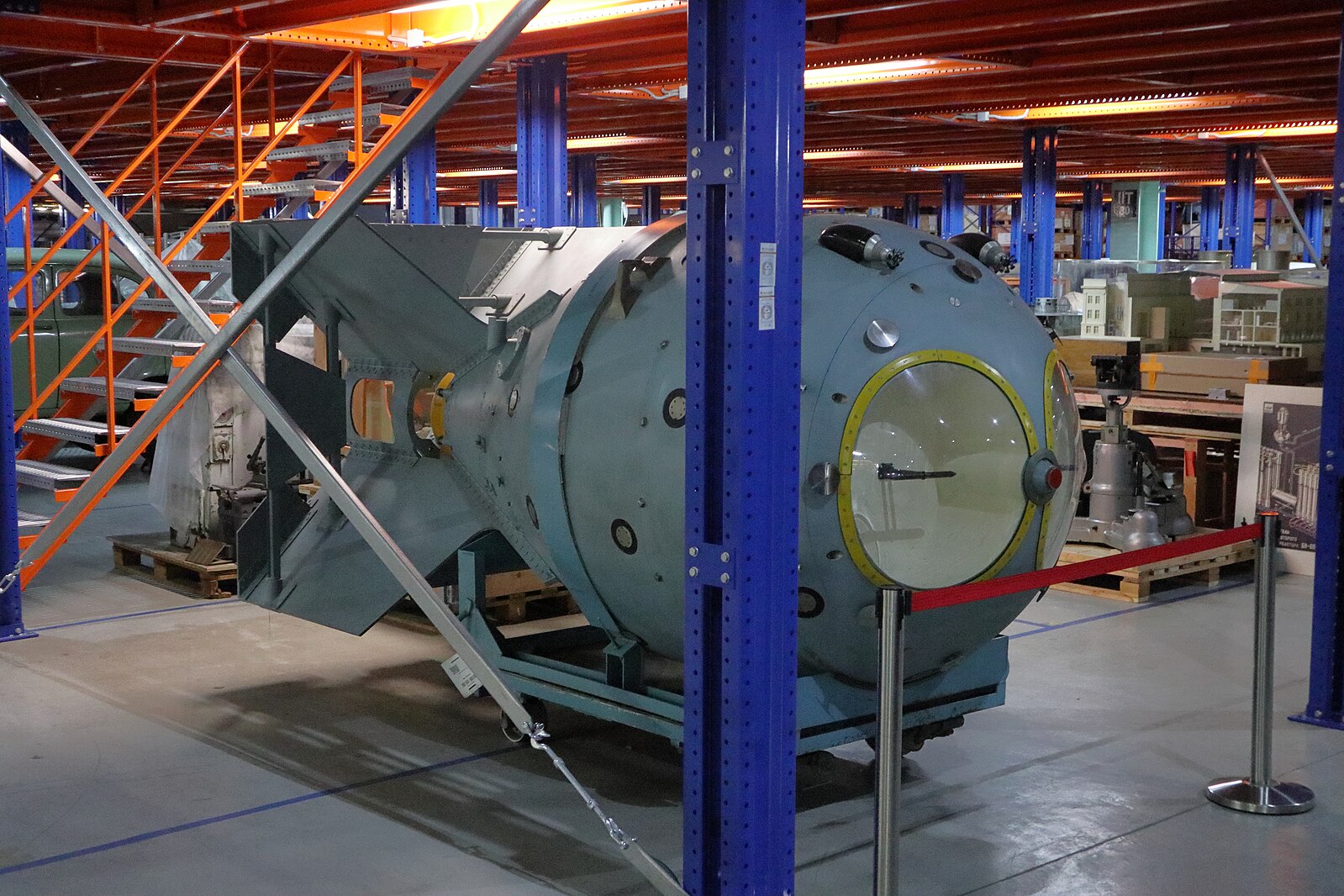OCR Specification focus:
‘the Warsaw Pact; atomic weapons’
Introduction
The Cold War between 1946 and 1955 saw escalating division in Europe, with alliances and nuclear developments shaping relations between East and West power blocs.
The Warsaw Pact
Origins and Purpose
The Warsaw Pact, formally known as the Treaty of Friendship, Cooperation, and Mutual Assistance, was signed in May 1955.
It was created in direct response to the integration of West Germany into NATO earlier that year.
Members: USSR, Poland, East Germany, Czechoslovakia, Hungary, Romania, Bulgaria, and Albania (though Albania distanced itself by the 1960s).
Aims:
Cement Soviet control over Eastern Europe
Provide a counterweight to NATO
Establish a military structure binding member states to Soviet leadership

Map of Cold War Europe in 1959 showing NATO members in blue and Warsaw Pact members in red, with neutral and non-aligned states distinguished. The map also visualises relative troop strengths, underlining the Pact’s role as the Soviet-led counterweight to NATO. Source
Warsaw Pact: A collective defence alliance formed by the USSR and seven Eastern European states in 1955, intended as the communist counterpart to NATO.
Unlike NATO, which allowed for shared command, the Warsaw Pact functioned as an extension of Soviet dominance, with Moscow directing political and military decisions.
Military Structure
The Pact created a Unified Command, nominally shared but in practice led by Soviet military officers.
Troops from member states were subordinated to Soviet strategic planning.
Soviet forces were permanently stationed in countries like East Germany, Hungary, and Poland.
This reinforced Soviet dominance and restricted the independence of Eastern European governments.
NATO and the Division of Europe
The creation of the Warsaw Pact solidified the bipolar division of Europe into two hostile blocs.
NATO’s expansion, particularly with the rearmament of the Federal Republic of Germany (FRG), prompted fears of a resurgent German threat.
The Warsaw Pact thus institutionalised the East–West divide, with a clear ideological and military frontier.
The Pact also provided the USSR with a legal and political framework for intervention in member states, justifying future interventions such as Hungary in 1956 and Czechoslovakia in 1968.
Atomic Weapons
Early Developments
The Cold War was defined by the presence of atomic weapons, which transformed international relations.
In 1945, the United States became the first nuclear power with the bombing of Hiroshima and Nagasaki.
The Soviet Union tested its first atomic bomb in 1949, ending the U.S. nuclear monopoly.

Museum mock-up of RDS-1, the Soviet Union’s first atomic bomb tested in August 1949. Its implosion-type design mirrored Fat Man, emphasising early superpower technological convergence. Source
Atomic Weapons: Explosive devices whose destructive power derives from nuclear reactions, either fission (splitting atoms) or a combination of fission and fusion.
The spread of nuclear technology marked the beginning of an arms race, where both superpowers sought strategic superiority.
Escalation and the Hydrogen Bomb
The 1950s brought rapid escalation:
The U.S. developed the hydrogen bomb (1952), a weapon far more powerful than earlier fission bombs.
The USSR followed with its own hydrogen bomb in 1953.
This raised the stakes of potential conflict, as nuclear war now threatened mutual destruction on an unprecedented scale.
The Doctrine of Deterrence
The existence of atomic weapons encouraged the policy of deterrence—the idea that possession of devastating weapons would prevent an enemy from launching an attack.
Mutually Assured Destruction (MAD) became a defining principle, though it was not formally articulated until the 1960s.
By the mid-1950s, both superpowers recognised that nuclear war would have catastrophic consequences for all.
However, the psychological and political impact of nuclear arsenals increased tensions, as each side feared technological or strategic inferiority.
Impact on Europe and the Cold War
Atomic weapons and the Warsaw Pact combined to reshape Cold War dynamics:
Security Dilemmas: NATO and the Warsaw Pact locked Europe into a cycle of armament and counter-armament.
Eastern Europe: The Warsaw Pact institutionalised Soviet dominance, reinforcing political repression and limiting independence.
Western Europe: The U.S. nuclear umbrella reassured NATO allies, but also created dependency on American protection.
Strategic Importance
The Warsaw Pact allowed the USSR to mobilise Eastern bloc armies quickly.
Atomic weapons transformed Cold War confrontations, where any escalation risked catastrophic nuclear war.
These developments deepened mistrust and polarisation, entrenching the East–West conflict for decades.
FAQ
Although presented as a defensive alliance, the Pact gave the USSR a legal mechanism to justify its dominance in Eastern Europe.
It allowed Moscow to:
Control the armies of satellite states.
Suppress nationalist movements.
Frame interventions as collective decisions, masking unilateral Soviet action.
The military threat from NATO was real, but the Pact’s main function was consolidating political authority.
Membership restricted independence, as military and foreign policy decisions had to align with Soviet priorities.
Leaders who tried to diverge—such as those in Hungary (1956) or Czechoslovakia (1968)—were met with force.
Thus, sovereignty was largely symbolic, with actual power subordinated to Moscow’s directives.
In 1955, West Germany was admitted into NATO and allowed to rearm.
For the USSR, this revived fears of German militarism and a potential invasion from the West.
The Warsaw Pact was framed as a defensive response, uniting Eastern bloc states under Soviet command to counterbalance NATO’s new strength.
European states were directly impacted by the nuclear arms race, as their territories became potential battlegrounds.
NATO allies relied heavily on the U.S. nuclear umbrella for protection.
Warsaw Pact states were pressured to host Soviet nuclear deployments.
This created unease, as smaller nations recognised that their survival depended on superpower strategies rather than their own policies.
The hydrogen bomb was vastly more destructive than fission bombs, with explosive yields in the megaton range.
Its creation meant any future war risked not just military defeat but total annihilation.
This intensified the climate of fear and encouraged policies of deterrence, ensuring nuclear weapons shaped superpower diplomacy far more than conventional forces.
Practice Questions
Question 1 (2 marks)
When was the Warsaw Pact established, and what was its primary purpose?
Mark Scheme:
1 mark for correctly identifying the year 1955.
1 mark for correctly stating its primary purpose (e.g. to counter NATO / consolidate Soviet control over Eastern Europe / provide a military alliance under Soviet leadership).
Question 2 (6 marks)
Explain how the development of atomic weapons affected relations between the USA and the USSR in the years 1949–1955.
Mark Scheme:
Up to 2 marks for describing the Soviet test of RDS-1 in 1949, ending the U.S. monopoly.
Up to 2 marks for noting the development of the hydrogen bomb by the USA (1952) and the USSR (1953), escalating the arms race.
Up to 2 marks for explaining the impact on relations, such as:
Increased fear and mistrust between superpowers.
Growth of deterrence policies.
Creation of an arms race that intensified Cold War tensions.
Maximum 6 marks: answers must address both events (atomic and hydrogen bomb) and their effect on relations to reach full marks.

